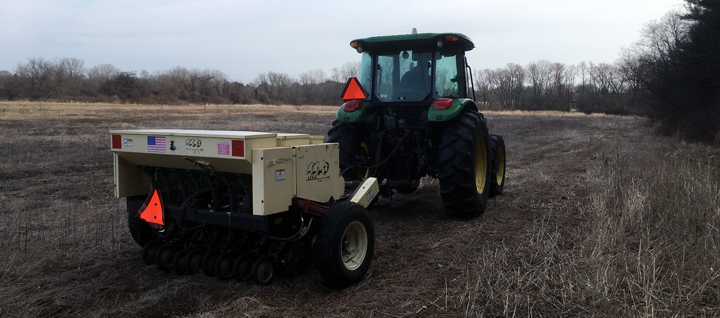
Smolenski Park and the Seed Idea
December 16, 2019 | Topics: Stories
Story and photos by Dave Giordano

It’s hard to imagine walking over the bridge in Smolenski Park in December and seeing a prairie rich in plant diversity and teaming with pollinators. Yet four years ago, we embarked on a partnership with the Village of Mount Pleasant with a clear vision to restore 15 acres inside the park. The vision was to create a pollinator paradise that would also filter and slow runoff to the North Branch of the Pike River. At the time, Root-Pike WIN had just overcome some significant operational challenges and began embracing a new approach – different from any other in our 20-year history. This new “seed idea” needed a win, and Mount Pleasant gave us a chance.
In a past life, seed idea was the term used to describe the inspirational morsel creative teams would use to grow their entire campaign, event or promotion. Today, for the broken Lake Michigan rivers we help restore, the seed idea takes on a much deeper and symbolic motivation to me, our organization and the watersheds we serve.

Approximately 10:30 one recent morning, a tractor pulling a drill seeder made its way into the fallow farmland within Smolenski Park. The operators from Tallgrass Restoration began inserting 40 different varieties of native grasses and flowers into the lightly frozen soil. The long and sometimes difficult process of planning the project, gaining approvals, raising the funds, coordinating the scope of work, selecting the contractor, rescheduling due to weather, managing the risks, compiling the grant reports, and overseeing the site preparation was over. The goal of a richer, more diverse pollinator habitat and passive recreational area was now a giant step closer to completion. Next spring, the oasis is set to bloom.

The seed idea also includes the motivation to leave a legacy or seed bank so that our diminishing natural assets are preserved for future generations to enjoy and experience. As the seed mixes were being prepared, I walked the normally uneventful area with my four-year old daughter Anna. She made many discoveries – including a “potato rock” and the fruit snack wrapper she had dropped earlier. Hands held, I reconnected to the reason for our mission. We have set out to leave the Root-Pike basin landscape better than when we got here – for my kids, your family, the community and the generations that follow. Clean water is a basic need and native plants are critical to the storage and filtration process.

Our seed idea – restoring our Watersheds through Initiative and Networking (WIN) with EPA/DNR-approved watershed restoration plans – is working. True, this project is a mere 15 acres within the thousands of acres of the basin that need help. Yes, it will take three to five years for the prairie to reach maturity. Is there far more to do to get our rivers off the EPA’s 303d impaired list? Indeed. Are we in a better position than four years ago to make more of these types of projects happen? Absolutely.

Our seed idea did not grow without the multitude of partnerships that have brought the Smolenski Prairie project, and many others, to reality. From elected officials to the parks committee to the development leaders to the public works staff, we owe a dept of gratitude to the Village of Mount Pleasant. We also want to highlight the support from the U.S. Fish and Wildlife Services and the Fund for Lake Michigan – they have been essential to so many of our partnerships. Finally, I want to recognize our former Board President, Bill Sasse, for his technical expertise and guidance in moving the project forward. His fingerprints are all over our success.
Dave Giordano is the Executive Director of Root-Pike Watershed Initiative Network. This article was first published on December 13, 2019 in the Root-Pike WIN newsletter. Reprinted with permission.

